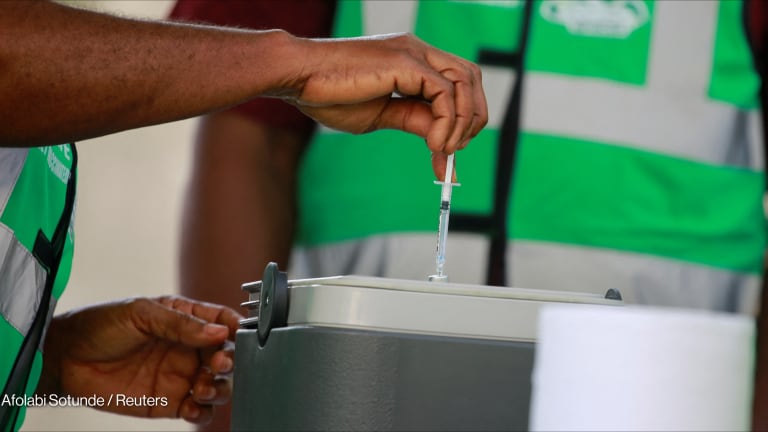
If COVID-19 has taught us anything, it’s that rapid testing is the key to pandemic response. The Biden administration has made eight free at-home tests available to every American household. And during last month’s State of the Union address — which required a negative COVID-19 test to attend — U.S. President Joe Biden announced a new “test to treat” initiative, promising free antiviral treatments “on the spot at no cost” to everyone who tests positive for COVID-19 at a pharmacy.
Yet, even as we double-down on testing in the United States, we’re denying this essential tool to much of the world. This week, the Senate eliminated global funding from the COVID-19 supplemental spending bill, leaving the world to fend for itself.
As the World Health Organization reported in October of last year, “testing inequity has been massive: of the more than 3 billion tests reported across the world, only 0.4% of these have been performed in LICs [low-income countries].” While the U.S. is now performing about two tests for 1,000 people per day — down from a peak of 7.7 tests per 1,000 people per day in January — populous African countries such as Nigeria and the Democratic Republic of Congo have languished at 0.02-0.08 tests per 1,000 people per day.
Overall, low- and middle-income countries are falling far short of the one-test-per-1,000-people-per-day target that Biden and global partners called for during the September 2021 White House COVID-19 Summit. This creates a dangerous blind spot for understanding the speed and spread of COVID-19 variants and forestalls the global rollout of vaccines, and especially COVID-19 oral therapies, which are useless without testing.
In response, WHO’s Access to COVID-19 Tools Accelerator has called for an “urgent step change … in the use of diagnostics to narrow the global equity gap,” with a focus on community- and home-based testing strategies.
But here’s the good news. A fever-testing infrastructure that could be used for COVID-19 already exists in many countries — and it can be converted to test for diseases such as COVID-19 at a fraction of what it would take to build such a robust system from scratch. I’m referring to the front-line malaria testing capacity that the U.S. President’s Malaria Initiative and The Global Fund to Fight AIDS, Tuberculosis and Malaria have helped countries to construct over the past 20 years.
As one of humanity’s oldest and deadliest diseases, malaria is currently a daily endemic threat for almost half the world. It turns out that COVID-19 typically shares seven of 10 primary symptoms with malaria, most notably fever. That makes malaria testing platforms especially powerful, not just in detecting COVID-19, but also for potential future pandemics, which are likely to present symptoms such as fever.
As Dr. Raj Panjabi, now senior director of global health security and biodefense at the White House, put it last year: “I bet my medical license that fever, a primary symptom of malaria and COVID-19, will be the first sign of the next pathogen with pandemic potential. That’s why we must invest in the world’s largest door-to-door fever surveillance network.”
In PMI-supported countries, testing rates for malaria are as much as 33 times higher than COVID-19 testing rates — exceeding the one per 1,000 people COVID-19 testing target. This is possible thanks to the standing army of community health workers and front-line clinics that diagnosed 267 million cases of fever with rapid malaria diagnostic tests in 2019. This has allowed them to identify and treat more than 190 million cases of malaria, which has contributed to cutting the number of child deaths from malaria by more than half.
Importantly, much of the malaria-testing infrastructure extends to rural, forested “hot spots” where malaria transmission thrives and where animal-to-human spillover events such as the one that probably spawned COVID-19 are most likely to occur.
There isn’t enough money or political will to do everything we could or should do to support the global COVID-19 response — the WHO-led ACT-A partnership has identified a gap of $7 billion for diagnostics for this year alone. But testing is foundational to global efforts to rollout COVID-19 vaccines and therapeutics. It’s also a bargain if we build on the already-paid-for and existing malaria testing infrastructure.
An additional investment of $329 million for PMI in the COVID-19 supplemental before Congress would help scale and accelerate testing for COVID-19, prepare for the next pandemic, and position the malaria campaign to save 4 million additional lives and prevent 1 billion more malaria cases over the next five years.
Rapid testing has become an indispensable part of our daily routines here in the U.S. Making this kind of testing available to the rest of the world is ambitious but essential. And thanks to the highly successful malaria programs the U.S. has built over the past 20 years, that goal is both affordable and achievable.








